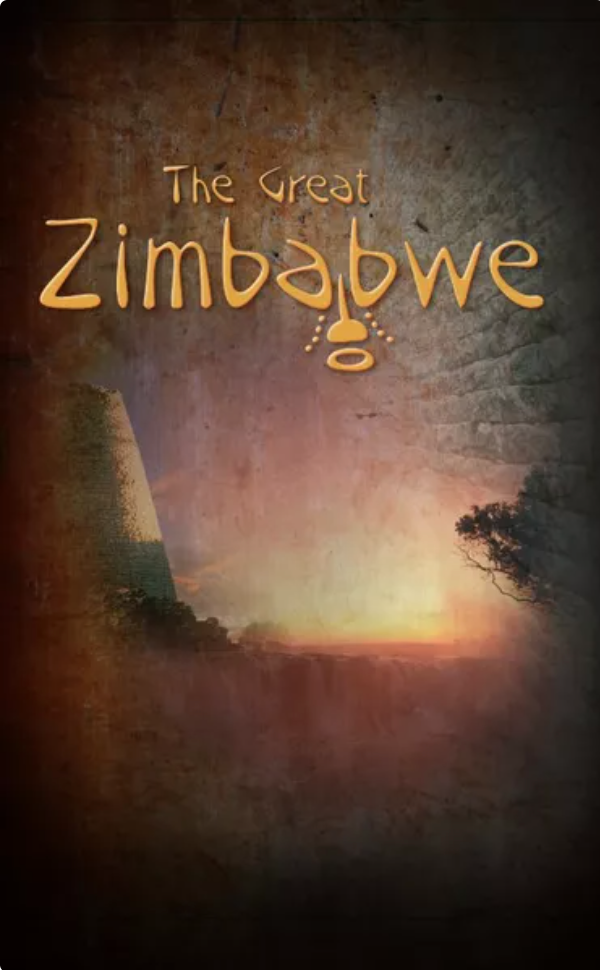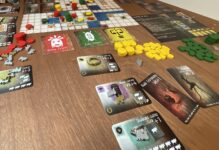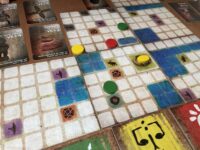- Learning time
- 60 minutes
- First play time
- 120 minutes
The Great Zimbabwe
Designed by: Jeroen Doumen,Joris Wiersinga
The Great Zimbabwe is complex, but it doesn’t actually come with a huge amount of rules. Instead, some fairly simple concepts and procedures interlink with each other in a way that makes a challenging and highly interactive game.
The board is actually made of tiles that are laid out in different ways depending on the number of players. Your goal is to score X amount of points: 20 at the start, but that target may go up, or even down! – and you do this, principally, by raising monuments. Everyone starts with a level one monument on the board, but during the game you’ll be adding more levels to monuments, to a maximum of five: and scoring points for doing so.
Each round of the game follows three phases. In the first, players bid for turn order – not that important in the first round, but increasingly so as the game continues. The bidding takes place by putting cows – the game’s equivalent of cash – out on the players Empire Plaques, going left to right. Like most auctions, each bid must be higher than the last, but The Great Zimbabwe runs a kind of circular distribution of bids where cows get distributed over the plaques before returning to the plaque’s owner before phase two starts. That’s the action phase, where everyone – in turn order – gets to do one action. You can start a new monument by placing a disc of your colour at any empty spot on the board, you can place craftsmen, or improve monuments. You can’t do the latter without the former, however, so let’s look at craftsmen.
To take a craftsmen you must first take a Technology card that matches that craftsmen, and place it in front of you. The technologies allow you to have the matching craftsman, for which you pay a a purchase price in cows. The craftsman is a tile that gets added to the board, that wants to be within three squares of the resource it uses: wood for wood carver, clay for the potter and so on: these resources are clearly marked on the map. This rule of three also applies to monuments: when you want to improve them by adding another level, you must pay craftsmen within three squares (including diagonals) of the monument, and pay a different type of craftsmen/resource for each level it has before adding the new one: so for example, to add a fourth level, you need to pay three different craftsmen for what they produce. You can, however, reach them by using other monuments as hubs; as long as you can reach between your monument (ie three spaces max!) and the hub you’re using, you can use as many hubs as you like, paying a cow each time for the privilege. How much you pay each craftsman; well, that’s up to the owner, who can set the price at anything between one and three cows.
The catch is that every time a craftsman is used during a round, it temporarily blocks a resource. Say a potter has three clay resources in reach, it can only be used a maximum of three times in any round: each time a craftsman is used, a marker is placed to track what resource has been used up, before being removed at the end of the round.
When everyone’s taken an action, players receive all income from the cows paid to their craftsmen, and additional cows equal to the height of their highest monument, and a new round begins – unless someone’s won.
Around that basic goal of building monuments, The Great Zimbabwe offers some strategic options in the form of God cards and Specialist cards. Both offer you additional help, special moves, bespoke powers and so on – the explanations for each are straightforward. But! You can only take one God card in a game and never change it. And both God cards and Specialist cards have a down-side: they increase how many points you need to win the game!
The guru's verdict
-
Take That!
Take That!
Players don't fight, but don't be fooled: the game is dripping with opportunities to make someone feel the pinch
-
Fidget Factor!
Fidget Factor!
Moderate. With its academic, theistic theme, and its slightly dry presentation, it's unlikely fidgety types would be calling out to play it. But each round is just one action per player.
-
Brain Burn!
Brain Burn!
Where to start? How much can and should you bid to go first? Which God serves your plan best? Should you mix in a specialist? This is before we get to the spatial/transportation aspect of the board itself, and what minor triumphs you can wring from that.
-
Again Again!
Again Again!
Massive. Variable, randomised boards, variable God cards, and most of all variable player input means The Great Zimbabwe will always demand your attention. The rulebook, the slightly underwhelming visuals, the learning curve of getting your head around each moving part - it can obscure what's here, but the entry fee is worth it.







Sam says
Despite the 7 pages of rules, The Great Zimbabwe can be tough to learn because of how everything interacts; from the bidding to the craftsmen to the transporting of resources and ritual goods, and that's without even explaining the secondary craftsmen, who kind of trump the first tranche whilst still demanding the same resource. There are some fringe rules we've not touched on here (though we should mention water offers extremely speedy access, as any water area costs a single move to cross), but boy, in a world where so many complex games need biblical rulebooks, what this offers in depth of play for a comparatively small amount of procedure is impressive. It does look pretty abstract, to be fair - no wide open savannahs here - and maybe the inspiration is partly submerged under the puzzle it offers. But that puzzle is thematically sound, cleverly distilled and highly, highly interactive. You could bounce off The Great Zimbabwe hard, and move on to prettier games. But if you like what is here, the rich blend of long-term strategy and guerrilla tactics, the surprisingly-fast first couple of plays before you find, as players get to know it, it slows down a tad for shrewd moves and cold calculation: this will keep you going for years.